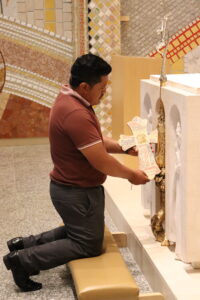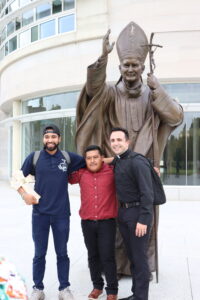Diocese facilitates World Youth Day pilgrimage to D.C. for young adults
By Gabrielle Nolan
The diocesan office of Youth, Young Adult, and Pastoral Juvenil Ministry led a pilgrimage Aug. 4-6 to Washington, D.C., for 20 young adults in conjunction with World Youth Day, an international event that occurs about every three years to bring together young people from around the world for prayer with the pope.
World Youth Day was held Aug. 1-6 in Lisbon, Portugal, gathering more than a million pilgrims.
The Diocese of Knoxville received a $4,000 grant from Catholic Home Missions to be used toward World Youth Day endeavors in mission dioceses.

A pilgrim touches the group’s pilgrim cross to a first-class relic of St. John Paul II at the St. John Paul II National Shrine.
Luis Garcia, a member of St. Patrick Parish in Morristown, said he “felt a connection… even though we didn’t go to Portugal. I felt like the connection was still present as if we were in Portugal. As a first-timer, I feel like this has opened my eyes in how many young adults are still present trying to connect with other young adults.”
Mr. Garcia was inspired to go on the pilgrimage because of “young adults still fighting for the love of God.”
“That’s what I love to see,” he continued. “I love seeing young people who are still wanting to see God’s love in this world.”
The theme of the event came from Luke 1:39, “Mary arose and went with haste.” The pilgrims were invited to reflect on the passage of Mary’s visitation to Elizabeth throughout the weekend.
Transitional Deacon Daniel Herman served as the chaplain for the pilgrimage.
“Instead of being more concerned about my spiritual growth and about my journey and about my pilgrimage, I’ve been tasked with facilitating a pilgrimage for others,” he said. “The prayer in which I prayed for this pilgrimage is very much different. I was still asking for the Lord to enliven in me the theme of this year’s World Youth Day, which was to go in haste and to go and share the love of God with others but also to help the other pilgrims really embolden that in themselves to go out and to foster a love of God so that way they can take that experience and share it with others; that way the love of God isn’t just confined to those who make the pilgrimage but to those who reap the fruit from those who have made pilgrimage.”
Deacon Herman discussed the difference between a vacation and a pilgrimage.
“A pilgrimage is a vacation if there is no prayer, so the ultimate difference is that it’s supposed to be rooted in a destination, but also to fully embrace what the journey is like,” he said. “A vacation is something that is enjoyable, it’s needed, and it’s very restful, but a pilgrimage is something where you’re striving for holiness. … It’s supposed to model life; life is a trip, life is a journey. You’re supposed to embrace whatever comes across your way, and in that way a pilgrimage is different from a vacation.”
One of Deacon Herman’s favorite moments of the trip occurred on the first night, when the pilgrims arrived after the long bus ride.
“We were very tired, very restless. … We stopped at a very inconspicuous, very run-down chapel with paint shedding on the sides, with a language that many of our pilgrims did not know, but inside was the Blessed Sacrament and was our Lord, and He was inviting us to rest with Him, to admire Him and to love Him, and to just sit with Him, just like Mary sat with Him on a daily basis,” Deacon Herman said. “And so, for me to see my pilgrims, to see my faithful, to see my friends, just sit in joy after a long journey and to soak up the holiness to prepare them for the sites they were about to see, that was probably my favorite (moment).”

A pilgrim feels a two-dimensional artistic scene of Calvary at the Franciscan Monastery of the Holy Land in America.
The pilgrims visited several holy sites in Washington, D.C., including the Basilica of the National Shrine of the Immaculate Conception, St. John Paul II National Shrine, and the Franciscan Monastery of the Holy Land in America.
“The Basilica of the National Shrine of the Immaculate Conception, a Catholic Church dedicated to the patroness of our nation, is a place of worship, pilgrimage, evangelization, and reconciliation,” according to its website. “It offers visitors the occasion for a deepening conversion, a step forward in the journey to God, with Mary as the model for that journey. This monumental church, raised by Catholics of the United States because of their devotion to Mary, the mother of God, gives visibility to their faith and Catholic heritage.”
The largest Roman Catholic church in North America, the Basilica of the National Shrine of the Immaculate Conception, is known for its blend of Romanesque-Byzantine art and architecture and features more than 80 chapels and oratories.
The pilgrims received a guided tour of the basilica and participated in Mass both in the Crypt Church and Upper Church.
John Vinti, a parishioner at St. Mary Parish in Oak Ridge, enjoyed the “magnitude of the basilica and the enormous amount of chapels that were inside.”
Citing his Polish family heritage, he particularly liked the Polish chapel dedicated to Our Lady of Czestochowa. “It was nice to pray and present some petitions for some of my loved ones in that chapel,” Mr. Vinti said.
The pilgrims also partook in a sacred-art tour of the Redemptor Hominis Church and Luminous Mysteries Chapel at the St. John Paul II National Shrine.
The shrine “is a place of worship, religious formation, and cultural renewal to feed the minds and souls of its visitors. It is a place of pilgrimage with a first-class relic of St. John Paul II’s blood available for veneration,” according to its website.
While at the shrine, the pilgrims were able to walk through an exhibit of St. John Paul II’s life and papacy. They also viewed a livestream of the World Youth Day events happening in Lisbon and engaged in group prayer.
A plenary indulgence was available to the pilgrims visiting the shrine, following the standard instructions of going to confession, receiving the Eucharist, and praying for the Holy Father’s intentions.

Pilgrims from the Diocese of Knoxville make their way to the Basilica of the National Shrine of the Immaculate Conception in Washington, D.C.
“The indulgence that you could receive from the JPII shrine is super important to me,” Mr. Vinti said. “Not only can you use it for yourself, or you could use it for somebody who may be in purgatory… it’s a great gift if someone you love could be in purgatory.”
The Franciscan Monastery of the Holy Land in America is a “national shrine that sustains this 800-year mission of the Franciscan Friars in the Holy Land by serving as a ‘Little Jerusalem’ in America. It serves America’s Holy Land pilgrims through education, fundraising, recruiting vocations, promoting pilgrimages, and providing pastoral ministry locally to religious, lay Catholics, and to all of good will. The Franciscan Monastery is home to a thriving Holy Land Franciscan community,” its website states.
The pilgrims had a guided tour of the Franciscan monastery, which included the main church, Calvary shrine, Purgatory chapel, Bethlehem shrine, replicas of the catacombs, and replicas from the Church of the Holy Sepulchre.
Outside on the grounds of the monastery, the pilgrims were able to visit the upper and lower gardens, a replica of the Portiuncula, and a mosaic rosary walk that featured the Hail Mary in 150 different languages.
“I was very fortunate to see the Franciscan Monastery of the Holy Land and see how these holy men from Jerusalem yearn to give that experience to people who cannot afford to go to Jerusalem and to be very exact in their measurements,” Deacon Herman said. “The tombs and the sepulchre all measure perfectly to mirror what’s in Jerusalem, which was very wonderful.”
Amanda Henderson, a parishioner at St. Thérèse of Lisieux in Cleveland, was inspired to go on the pilgrimage because of her friendship with Deacon Herman, and she thought “this was a great opportunity to get our Chattanooga young adults involved in diocesan events.”
Ms. Henderson was struck by the diversity of the pilgrims.
“We had a lot of different cultures on this trip, so being able to experience the different languages… I came to realize how fortunate I was with the English language and being able to understand Mass anytime I want to, wherever I want to. Going to Spanish Mass was really eye-opening for me to be experiencing that in a different language,” she said.

Pilgrims pose for a photo with pilgrimage chaplain Deacon Daniel Herman outside of the St. John Paul II National Shrine.
Deacon Herman said, “it was only fitting that we had a group of very diverse pilgrims because World Youth Day was meant to draw all people together for the love of God and for love of neighbor.”
“Our diocese is very rich and diverse; it’s not your typical East Tennessee mentality when you think about the Catholic Church,” he continued. “It’s very rich, and it’s not just one particular country that’s decided to call East Tennessee home. There’s Venezuelans, Hondurans, Mexicans, Guatemalans, and of course native English speakers. … I really loved the challenge that presented to make sure that all the pilgrims were being spiritually fed and to make sure they were known, loved, and heard.”
The next international World Youth Day will be held in Seoul, South Korea, in 2027.
“Deacon Danny was really great, and we had a really good group,” Mr. Vinti said. “If somebody’s looking to do something affordable next time for Seoul, and they can’t make it (there), they should definitely look into going with the diocese because it’s super affordable, and it’s a great time.”

